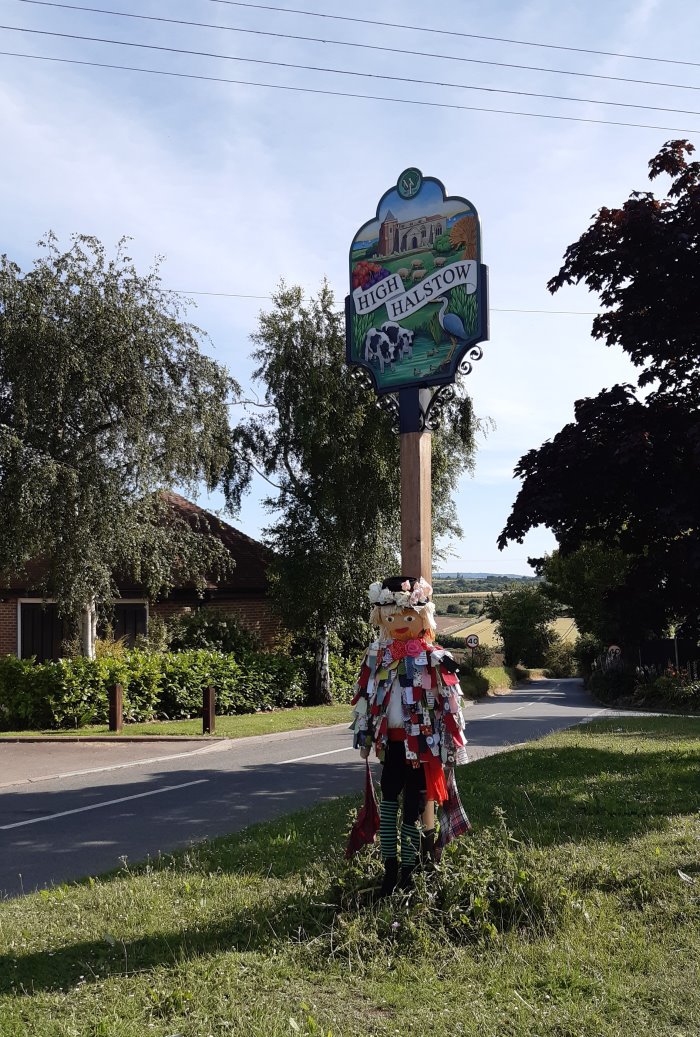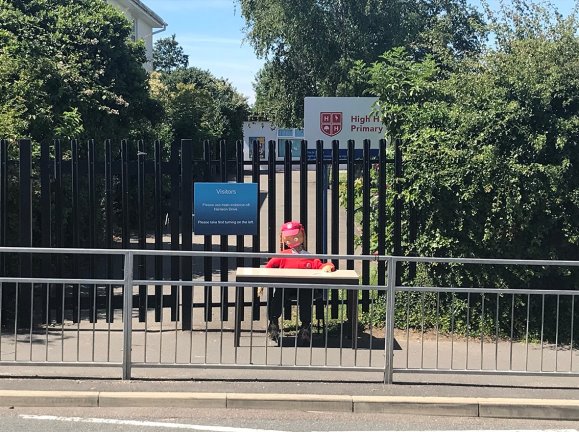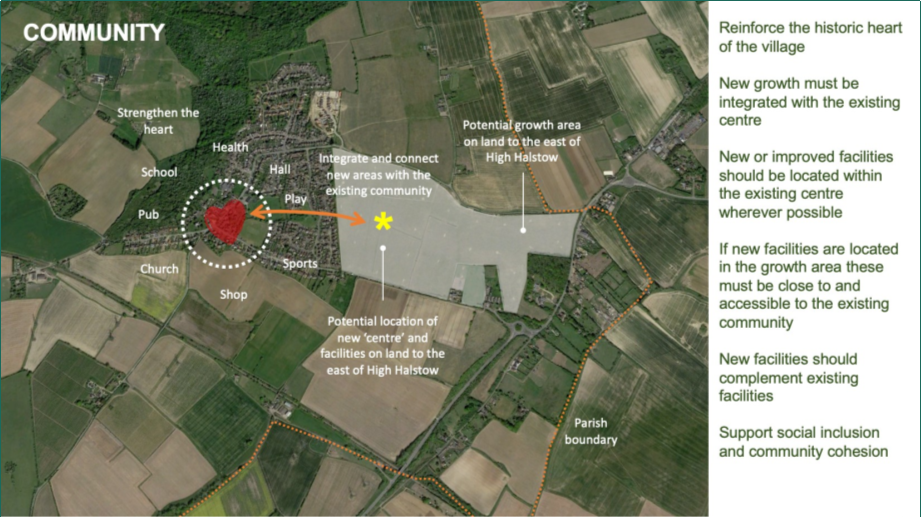High Halstow Neighbourhood Plan - Regulation 16
4. Community

4.1 The policies and projects contained within this section of the Neighbourhood Plan relate to the objectives outlined below and are summarised in Figure 5:
Objective 01:
To provide and enhance facilities that maintain and develop the wellbeing of the community.
Objective 03:
To maintain and enhance the strong sense of community and maximise the opportunity for engagement.
Objective 08:
To provide an effective locally based healthcare facility to suit the needs of the local population.
Objective 10:
Provide infrastructure that is robust enough to support existing and future networks.
Village Centre and facilities
4.2 The presence of and provision of social and community infrastructure is critical to sustaining the life of a rural parish, providing access to essential services and facilities.
4.3 The heart of the village is along The Street and at the junction with Christmas Lane, Cooling Road and Dux Court Road (Figure 5). A range of facilities providing for day- to-day needs are found here, including High Halstow Primary School and pre-school, St Margaret's Church, the Village Hall, the War Memorial Hall, The Red Dog public House, High Halstow Sports Field and Cricket Club. The Village Hall is home to a range of clubs and societies, and is also used as a branch of the Elms Medical Practice, though this is only open three half days a week, with residents needing to travel to Hoo St Werburgh or Strood for appointments outside these days. Close by, on Christmas Lane, is the village store/post office.
Figure 5: Indicative concept plan showing summary of aspirations for the village centre and provision of new or improved facilities (image source: Google Earth)
4.4 The location of the village centre reflects the original, organic growth of the village, and thus its identity. It has a strong influence on local character and sense of place. The clustering of these facilities is also important for social cohesion and supports the general health and well-being of the community.
4.5 If future growth of High Halstow takes place of a scale envisaged by the HIF funding and vision for the Peninsula, new facilities and services will be required to support the new population. These facilities should support and reinforce the centre of the Village, with links provided that enable access to these from the new growth area (Figure 5). If significant development takes place on the LEHH, it will be necessary to provide new local infrastructure in the village. This may come forward on LEHH providing a new village centre.
4.6 The provision of new health facilities is important for the village. The Medway Infrastructure Position Statement (January 2017) notes that, across Medway as a whole, there is shortfall of GPs, as well as a need to attract new GPs to the area as a high proportion of the current cohort of GPs is reaching retirement age.
4.7 Although the Village Hall is used as a part-time surgery, purpose built facilities are required in close proximity to the population, particularly as the population is aging and, with growth to the east of High Halstow, expanding. New health facilities in the village that reduce the need to travel elsewhere will be supported.
4.8 Policy HH C1 lists important facilities within the village centre that should be protected from loss. Where appropriate, opportunities should be explored that support the ongoing maintenance and improvement of these facilities. This might extend to the provision of publicly accessible water fountains and bottle refill points, which are important for health and well-being, as well as being a positive response to the climate change agenda.
4.9 Located to the rear of the Village Hall car park are public conveniences. The Royal Society for Public Health has stressed the importance of public conveniences and the impact of poorly maintained facilities, or closure of such facilities, on public health. However, with continuing cuts to public funding there is a risk that such facilities may not survive. The Parish Council wishes to safeguard provision of the public conveniences but recognises that this might only be possible through expansion of the facilities, potentially incorporating them within changing facilities for the adjacent sports ground, such that they provide a wider function.
Policy HH C1: Village centre and facilities
- Important local services and facilities in High Halstow are:
- High Halstow Village Hall
- The War Memorial Hall
- High Halstow primary and pre-school
- St Margaret's Church
- Red Dog Public House
- Village Store/Post Office
- Public Conveniences
- Cricket club
- Recreation/sports ground
- Garage/shop
- Applications that would result in the loss of important services and facilities in High Halstow will be resisted unless:
- Alternative provision is made for that use, within the village.
- Alternative provision is, as far as is possible, located within the village centre.
- The application is supported by material which demonstrates the benefits to the community and which outweigh the harm created by the loss of that facility.
- The use is no longer viable, as demonstrated by market evidence of at least six months vacancy despite reasonable attempts to let.
- Applications to enhance and provide additional community facilities will be supported. These should be:
- Accessible to all, capitalising on opportunities to promote walking, cycling and use of public transport.
- Include provision of flexible space that can be used for a variety of community uses.
- Where possible, new social and community facilities to be provided or contributed towards as a result of new growth should be located in the village centre. Where facilities are to be provided within areas of new development they should be as close as possible and well connected to the existing built-up area of High Halstow.
- New facilities that would be supported include a health centre, café and employment hub. Provision of an employment hub, with online and video conferencing capabilities, as well as creche and primary school places, will help support local lifestyles arising from the Covid pandemic.
- Proposals that incorporate the public conveniences within changing facilities for the sports ground will be supported. These shall remain accessible to the public.
- Proposals for provision of water taps and water bottle refill points are welcome. They should be appropriately designed to reflect the setting and should not cause obstruction in the public realm. Potential locations for such facilities include the Village Hall car park.
Education
4.10 Medway Council notes that there is currently limited capacity for additional school places and new facilities are needed across all ages within the authority area. Therefore, any additional residential development would be expected to contribute to an expansion of existing educational facilities or the development of new facilities, to address the increase in demand.
4.11 The scale of growth envisaged in the developer's proposals for the land to the east of High Halstow (LEHH) will generate a demand for new school places, including an expanded or new primary school within High Halstow, as well as expansion of secondary school places elsewhere, with supporting transport infrastructure also put in place.
4.12 The delivery of new primary school places within High Halstow will be developed through the masterplan to be prepared by the developers for land to the east of High Halstow in discussion with the local education authority. The options are:
- Expand the existing High Halstow Primary and pre-school to accommodate new pupils.
- Provide a new primary and pre-school including outside classrooms on land to the east of High Halstow to accommodate new pupils.
- To provide a larger primary and pre-school including outside classrooms on land to the east of High Halstow that accommodates existing pupils at the High Halstow primary school and new pupils generated from the development, and which would result in the closure of the existing primary school.
4.13 The preference would be for a school presence either to be maintained in the village centre or a new school to be provided within the growth area, should the LEHH proposals be granted planning permission. This should be in close proximity to the existing community and with good access provided by foot and by bicycle. Schools often become a focus for community life and thus it is important that any new school is located in close proximity to the existing built-up area, supporting community cohesion and integration between existing and new areas.
4.14 Efforts that minimise the 'school-run' and the consequent traffic congestion associated with this will be supported. This includes the use of 'school streets', which restrict motorised traffic at drop-off and pick-up times, creating pedestrian friendly areas around the school. These are safer places for all, promote healthy lifestyles by encouraging people to use alternative means of travel to the car, and improve air quality through reduced vehicle movements and idling13.
4.15 Should the existing school need to close and pupils relocate, the impact of that on the village centre will need to be considered. Re-use of the existing school site for alternative community facilities should be explored in the first instance, including opportunities for the co-location of facilities, such as nursery space and health facilities. Where the scale of growth on land to the east of High Halstow generates a need for other supporting uses, the current school site may be an appropriate location for these. This will help integrate the existing and new development area, foster social cohesion and support the vitality of the village centre.
4.16 Furthermore, and as outlined in Section 7 of the Neighbourhood Plan, the ageing population may bring challenges in terms of housing, with homes for elderly residents needed. Such housing should ideally be located in close proximity to community facilities. Reuse of the school site for such housing might be appropriate, subject to conformity with other policies in the Development Plan.

Policy HH C2: Education
- Where development is of a scale that triggers the need for new primary school places these should, in order of preference, take the form of:
- Expansion of the existing High Halstow Primary and pre-school, unless the existing site is too small to accommodate additional forms of entry.
- Delivery of a new primary and pre-school including outside classrooms on land to the east of High Halstow which caters for the pupil numbers generated by that development.
- Delivery of a new primary and pre-school including outside classrooms that accommodates pupils at the existing primary school as well as those generated by new development.
- In the event that a new school is provided that results in the closure of the existing primary school then that site should be used for alternative community facilities wherever possible, including those needed as a result of the new development of land to the east of High Halstow. Reuse of the existing school site to include housing may be acceptable, where that forms part of a mixed use scheme including community facilities and where the housing includes provision for senior residents.
- Where located within new areas of growth, school buildings should be located as close as possible to the existing village, maximising connectivity and access for existing and new pupils.
- Where a new school is to be provided, this should be delivered during the initial phases of development to help build community cohesion and minimise disruption for existing and new pupils.
- The design and layout of the any new school should promote walking and cycling, minimising trips made by car. The provision of school streets around the school which minimise vehicular routes and traffic speeds will be supported.
Communication technology
4.17 Access to broadband is a vital component of digital infrastructure and is key to growing a sustainable local economy, vital for education and home working and increasingly central part of community cohesion and resilience, particularly in rural areas. Indeed, the NPPF states that:
'advanced, high quality and reliable communications infrastructure is essential for economic growth and social-wellbeing'14
4.18 The importance of reliable and fast broadband services was highlighted during the COVID-19 pandemic, with many people required to work from home and undertake home schooling. And, with people unable to leave home other than for essential trips, the need for reliable broadband became ever more important, being a means for people to stay connected with friends and family, to access information, particularly in relation to health matters, and to arrange home deliveries.
4.19 From data provided by Ofcom the average broadband download speed in the centre of the settlement of High Halstow is 32 megabits (MBps) compared to 19Mbps on the outskirts15. These are relatively slow: faster broadband speeds of 50-100+Mbps support use by multiple devices in the home, allowing more than one person to access the internet at any one time, supporting home working, learning and wider social connectivity.
4.20 Kent County Council and Medway Council are working with the Government's Building Digital UK team as well as BT Openreach to improve broadband speeds. This includes a rural fibre broadband project and top-up voucher scheme. Ofcom's 'outside in' programme will also make funding available to improve fibre deployment in rural locations.
4.21 Along with improvements to broadband speeds there is also a need to improve mobile phone reception, the quality of which varies across the Neighbourhood Plan area depending upon network operator and which is limited in many places16. The Government has announced funding to improve mobile phone reception in rural areas17. Where necessary, improvements to reception may include the need for new mobile phone masts. Where provided, these should be designed to minimise visual intrusion and respond to the character of the area.
Policy HH C3: Communication Technology
- Proposals for new development should be capable of receiving high, gigabit- capable speeds and reliable mobile and broadband connections.
- The appropriate cabling and ducting shall be provided to the premises and linked to infrastructure networks to enable the fastest available connections.
- Any above ground installations required to improve broadband speed or mobile phone reception shall be located and designed such that any potential adverse visual impacts are minimised.
13 More information on school streets can be found via http://schoolstreets.org.uk/ (accessed July 2020)
14 Para 114, MHCLG, July 2021, NPPF
15 Consumer Data Research centre (CDRC). Broadband Speed 2017: https://maps.cdrc.ac.uk/#/metrics/bband/default/BTTTFFT/13/0.5701/51.4556/
16 See: https://checker.ofcom.org.uk/mobile-coverage accessed July 2020
17 See: https://www.gov.uk/government/news/1-billion-deal-set-to-solve-poor-mobile-coverage accessed July 2020
